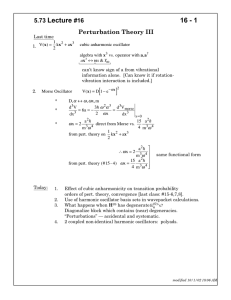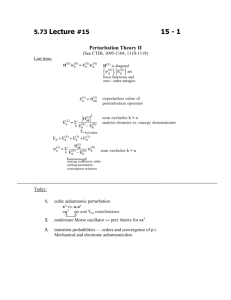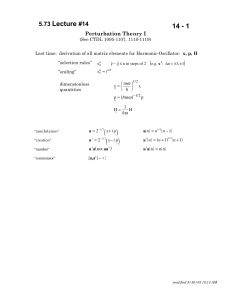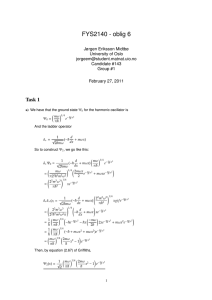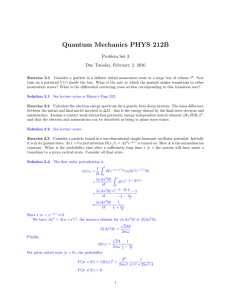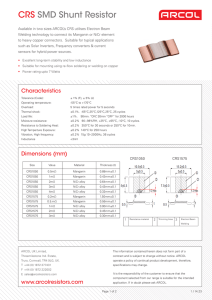{ } 15 - 1 Lecture 5.73
advertisement
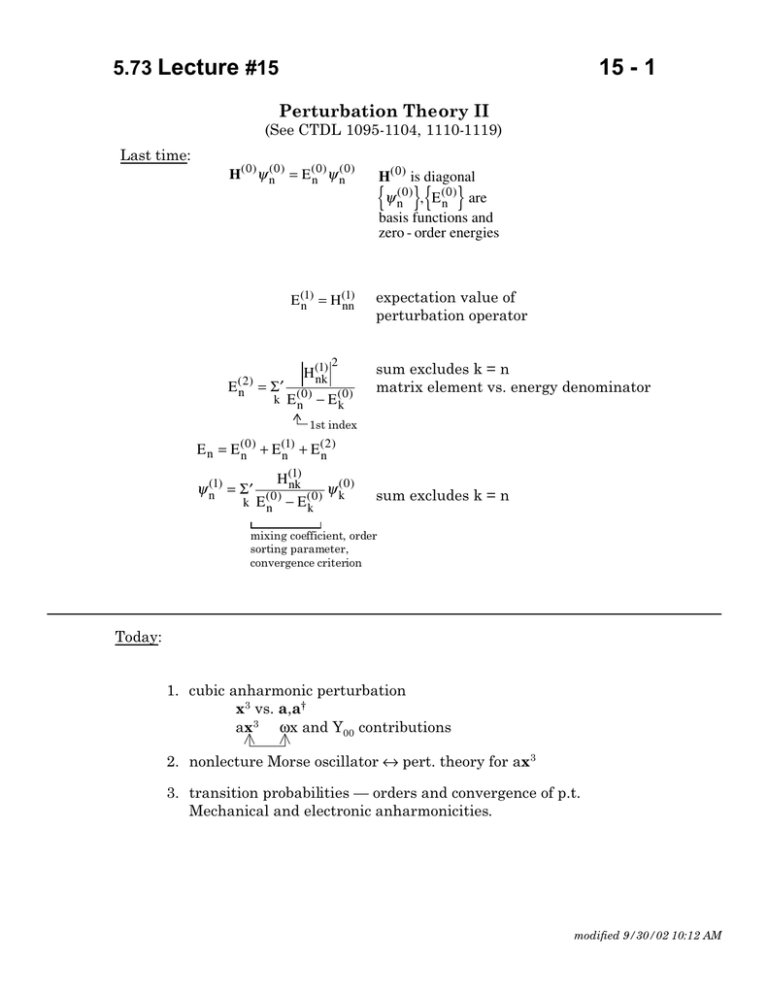
5.73 Lecture #15
15 - 1
Perturbation Theory II
(See CTDL 1095-1104, 1110-1119)
Last time:
(0)
H(0) ψ n(0) = E (0)
n ψn
(1)
E (1)
n = H nn
E (2)
n
H(1)
nk
2
= Σ ′ (0)
(0)
k En − Ek
H(0) is diagonal
ψ n(0) , E(0)
are
n
basis functions and
zero - order energies
{ }{ }
expectation value of
perturbation operator
sum excludes k = n
matrix element vs. energy denominator
1st index
(1)
(2)
E n = E(0)
n + En + En
H(1)
ψ n(1) = Σ ′ (0) nk (0) ψ k(0)
k En − Ek
sum excludes k = n
mixing coefficient, order
sorting parameter,
convergence criterion
Today:
1. cubic anharmonic perturbation
x3 vs. a,a†
ax3 ωx and Y00 contributions
2. nonlecture Morse oscillator ↔ pert. theory for ax3
3. transition probabilities — orders and convergence of p.t.
Mechanical and electronic anharmonicities.
modified 9/30/02 10:12 AM
5.73 Lecture #15
Example 1. H =
15 - 2
p2 1 2
+ kx
2m 2
+ax 3
H(1)
H(0)
V(x)
(a < 0)
unphysical
x
need matrix elements of x3
one (longer) way
x3il = ∑ x ijx jk x kl
j,k
l
4 different selection rules: l – i = 3, 1, –1, –3
–i=3
i → i +1, i + 1→ i + 2, i + 2→ i + 3
one path
[(i + 1)(i + 2)(i + 3)]1/ 2
l
i → i + 1, i + 1→ i + 2, i + 2→ i + 1
i → i – 1, i – 1→ i, i → i + 1
i → i + 1, i + 1→ i, i → i + 1
–i=1
There are three 3-step paths from i to i + 1. Add them.
[(i + 1)(i + 2)(i + 2)]1/ 2 + [(i)(i)(i + 1)]1/ 2 + [(i + 1)(i + 1)(i + 1)]1/ 2
algebraically complicated
other (shorter) alternative: a, a†, and a†a
h
x =
mω
3
3/ 2
h
x~ =
mω
3/ 2
3
[
3/ 2
(
2 −1/ 2 a + a †
)]
3
(a + a )
3
(a + a† ) = a3 + [a†aa + aa†a + aaa† ] + [aa†a† + a†aa† + a†a†a] + a†
h
=
2mω
† 3
3
four terms, four different selection rules.
modified 9/30/02 10:12 AM
5.73 Lecture #15
15 - 3
Use simple a,a† algebra to work out all matrix elements and selection
rules by inspection.
recall: a† n = ( n + 1)1/2 n + 1 , a n = n1/2 n − 1 , a†a n = n n
a,a† = 1
∴
prescription for
[ ]
aa† = 1 + a†a
permuting a thru a†
1/2
∆n = –3 a 3n−3,n = [( n − 2)( n − 1)( n )]
1/2
∆n = +3 a†3
n+3,n = [( n + 3)( n + 2 )( n + 1)]
∆n = −1
[a†aa + aa†a + aaa† ]n−1,n
goal is to rearrange each product so that it
has number operator at right
a†aa = aa†a − a
aaa† = aa†a + a
aa†a = aa†a
3aa†a + 0
∆n = –1
∆n = +1
[ ]n−1,n = 3(aa†a )
n−1,n
† †
( )
= n − 1 3a a†a n = 3n 3/2
[aa†a† + a†aa† + a a a]
aa†a† = a†aa† + a† = a†a†a + 2a†
a†aa† = a†a†a + a†
a †a †a = a †a †a
3a†a†a + 3a†
(
)
(
)
3 n + 1 a†a†a + a† n = 3 n( n + 1)1/ 2 + ( n + 1)1/ 2 = 3( n + 1)3/ 2
all done — not necessary to massage the algebra as it would have
been for x3 by direct x multiplication!
modified 9/30/02 10:12 AM
5.73 Lecture #15
15 - 4
Now do the perturbation theory:
H(1)
nk
2
(1)
(2)
E n = E (0)
n + E n + E n = hω ( n + 1 / 2 ) + 0 + Σ ′ (0)
k E n − E (0)
k
3
x nn = 0
H(1)
nk
2
(0)
E(0)
n − Ek
k = n−3
h 3
a
( n − 2)( n − 1)( n )
2mω
+3hω
k = n −1
h 3 3
a
9n
2mω
+1hω
k = n+3
h 3
a
9( n + 1)3
2mω
−1hω
k = n+3
h 3
a
( n + 3)( n + 2)( n + 1)
2mω
−3hω
2
2
2
2
E (n2)
h
a2
2mω
=
hω
3
( n − 2)( n − 1)( n) ( n + 3)( n + 2)( n + 1) 9 n 3 9( n + 1)3
−
+
−
3
3
1
1
2 nearly cancelling pairs
all of the
constants
E(n2 ) =
[
]
a 2h 2
2
−30(n + 1 / 2 ) − 3.5
3 4
8m ω
E(n2 ) = −
a 2h 2 15
7
2
n + 1 / 2) +
3 4 4 (
16
mω
algebra
(m3ω 4 = mk 2 )
all levels shifted down regardless of sign of a — can’t measure sign
of cubic anharmonicity constant, a, from vibrational structure alone
15 a 2 h
7 a 2h
2
−
h
v
+
1
/
2
(
)
4 m 3ω 4
16 m 3ω 4
hω e x e
hY 00
E n = h Y 00 + ω e ( v + 1 / 2) − ω e x e ( v + 1 / 2)2 + ω e y e ( v + 1 / 2)3…
E n = hω ( n + 1 / 2) − h
[
]
ax3 makes contributions exclusively to Y00 and ωexe
modified 9/30/02 10:12 AM
5.73 Lecture #15
15 - 5
Nonlecture
Morse Oscillator via perturbation theory
[
V( x ) = D 1 − e
[
by WKB or DVR
]
− αx 2
E n = h ( n + 1 / 2)ω − ( n + 1 / 2)2 ω x
]
known in advance — compare to pert. theory
applied to Taylor series expansion of V(x)
Our initial goal is to re-express the Morse potential in terms of ω and ωx rather than
D and α. Then we will expand VMORSE in a Taylor series and look at the coefficient of
the x3 term. First we must take derivatives of Ev with respect to v ≡ n + 1/2
at dissociation,
dE v
= 0 = h(ω − 2( n + 1 /2)ωx)
dv
ω
= nD + 1 /2
2ωx
at dissociation asymptote
ω
ω2
∴ D = E n D = h
ω−
ω
x
4ω x 2
2ω x
( nD + 1 / 2 )2
nD + 1 / 2
D=h
ω2
4ω x
now expand V(x)
V( 0 ) = 0
hω 2
+2α e − αx − 2α e −2αx , V ′(0) = 0
V ′(x) =
4ω x
2 2
hω 2
hω 2
2 − αx
2 −2 α x
2 hα ω
−2α e
+ 4α e
, V ′′(0) =
2α =
V ′′(x) =
4ω x
4ω x
2ω x
2 3
3h
ω
α
hω 2
+2α 3e − αx − 8α 3e −2αx , V ′′′(0) = −
V ′′′(x) =
4ω x
2ω x
[
[
[
]
]
]
but
hα 2 ω 2
2mω x 1/2
→α =
V ′′(0) ≡ k = mω =
h
2ω x
3/2
2
3 hω 2mω x
V ′′′(0) = −
2 ωx h
1 2
V(x) = kx + ax3 thus V ′′′(x) = 6a
2
1 hω 2 2mω x 3/2
1 ω 4 m 3ω x
a=−
→ a2 =
4 ωx h
2
h
2
now we can eliminate α from
higher derivatives (at x = 0).
This is to be compared to V′′′(0)
for the cubic anharmonic
potential.
modified 9/30/02 10:12 AM
5.73 Lecture #15
15 - 6
a 2h
m 3ω 4
15 a 2 h
from pert. theory (#15 - 4) ω x =
4 m 3ω 4
∴ ωx = 2
same functional form but different
numerical factor (2 vs. 3.75)
One reason that the result from second-order perturbation theory applied
directly to V(x) = kx2/2 + ax3 and the term-by-term comparison of the power
series expansion of the Morse oscillator are not identical is that contributions
are neglected from higher derivatives of the Morse potential to the (n + 1/2)2
term in the energy level expression. In particular
hω 2 α 4 4
4
E (1)
=
V
0
x
4!
=
7
/
2
′′′′
( )
x 24
n
ωx
h 2
n x4 n =
4( n + 1 / 2)2 + 2
2mω
[
]
contributes in first order of perturbation theory to the (n + 1/2)2 term in En.
E (1)
n =
Example 2
7
7
ω x ( n + 1 / 2 )2 + ω x
12
24
Use perturbation theory to compute some property other than Energy
need ψ n = ψ n(0) + ψ n(1) to calculate matrix elements of the operator in question,
for example, transition probability, x: for electric dipole transitions, transition
probability is P n ′ ←n ∝ x nn ′ 2
For H - O n → n ± 1 only
h
2
x nn+1 =
( n + 1)
2mω
for perturbed H-O
H(1) = ax3
Standard result. Now allow for
mechanical and electronic
anharmonicity.
H(1)
ψ n = ψ n(0) + Σ ′ (0) kn (0) ψ k(0)
k En − Ek
H(1)
H(1)
H(1)
H(1)
(0)
(0)
(0)
(0)
ψ n = ψ n(0) + nn+3 ψ n+3
+ nn+1 ψ n+1
+ + nn−1 ψ n−1
+ nn−3 ψ n−3
−3hω
−hω
hω
3hω
modified 9/30/02 10:12 AM
5.73 Lecture #15
ψ n(0) + ψ n(1)
initial
state
15 - 7
effect
of x
n+4
ψ n(0)
anharmonic
final state
n+7 , n+5, n+4, n+3, n+1
n+3
n+2
n+1
n+1
n
n
n
n–1
n–1
n–2
n–3
n–4
n+5, n+3, n+2, n+1, n–3
n+4, n+2, n+1, n, n–2
n+3, n+1, n, n–1, n–3
n+2, n, n–1, n–2, n–4
n+1, n–1, n–2, n–3, n–5
n-1, n-3, n-4, n-5, n-7
Many paths which interfere constructively and destructively in x nn ′
2
n ′ = n + 7, n + 5, n + 4, n + 3, n + 2, n + 1, n, n – 1, n − 2, n − 3, n − 4, n − 5, n − 7
only paths for H-O!
The transition strengths may be divided into 3 classes
1. direct: n → n ± 1
2. one anharmonic step n → n + 4, n + 2, n, n – 2, n – 4
3. 2 anharmonic steps n → n + 7, n + 5, n + 3, n + 1, n – 1, n – 3, n – 5, n – 7
Work thru the ∆n = –7 path
h
nxn +7 =
2mω
x3n,n+3
1/2
a
n + 1)( n + 2)( n + 3) ( n + 4) ( n + 5)( n + 6)( n + 7)
2 (1
2444
3 123 144424443
( −3hω ) 444
x n,n +3
x n +3,n +4
x n +4,n +7
3/2+3/2+1/2
2
x n+3,n+4
x3n+4,n+7
h3a 4 n 7
x nn+7 ∝ 4 7 7 11
3 2 m ω
2
modified 9/30/02 10:12 AM
5.73 Lecture #15
*
15 - 8
you show that the single-step anharmonic terms go as
h 3/2+1/2
a
1/2
x nn+4 ∝
n + 1)( n + 2)( n + 3)( n + 4)]
(
[
2mω
( −3hω )
x nn+4
*
2
h2a 2 n 4
∝ 2 4 4 6
3 2 m ω
Direct term
h1
x nn+1 ∝
( n + 1)
32m1ω 1
2
hn 3a 2
each higher order term gets smaller by a factor 32 23 m 3ω 5
which is a very small dimensionless factor.
RAPID CONVERGENCE OF PERTURBATION THEORY!
What about Quartic perturbing term bx4?
Note that E (1) = n bx 4 n ≠ 0
and is directly sensitive to sign of b!
modified 9/30/02 10:12 AM
